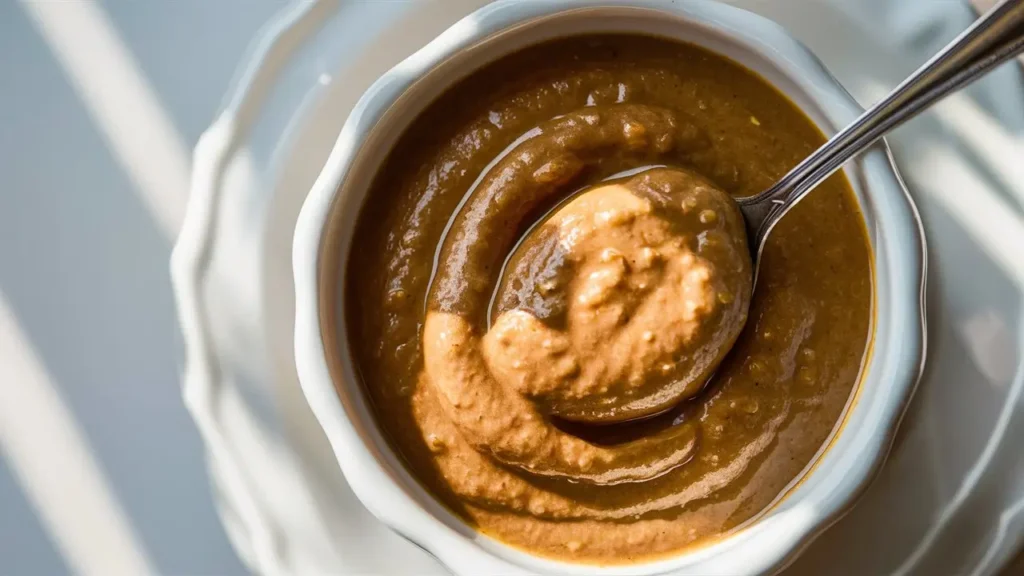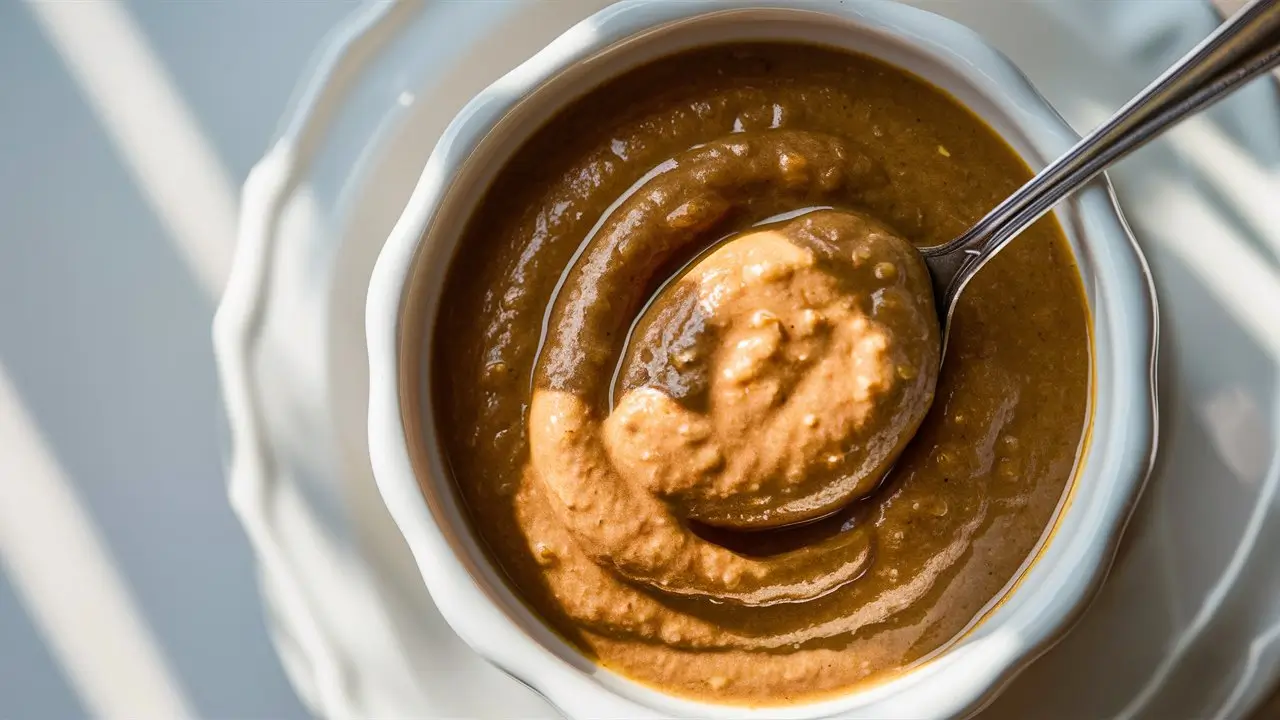Peanut sauce is a rich, creamy, and nutty condiment that adds a burst of flavor to many dishes. Originating in Southeast Asia—particularly Indonesia and Thailand—this sauce is now a global favorite. Whether you’re dipping satay, tossing noodles, or using it as a salad dressing, peanut sauce delivers a delightful balance of savory, sweet, tangy, and spicy notes.
Homemade peanut sauce is incredibly easy to make and tastes much better than store-bought versions. With a handful of pantry ingredients, you can whip up a versatile sauce that elevates anything it touches.
Why You Will Love This Recipe
-
Quick and Easy – It takes just 5–10 minutes to prepare.
-
Versatile – Works as a dip, dressing, marinade, or stir-fry sauce.
-
Customizable Heat and Sweetness – Adjust the spice level and sweetness to your taste.
-
Made with Pantry Staples – No need for fancy ingredients or a trip to a specialty store.
Ingredients List
To make a classic and flavorful peanut sauce, you’ll need:
Basic Ingredients:
-
½ cup creamy peanut butter (natural or regular)
-
2 tablespoons soy sauce
-
1 tablespoon rice vinegar or lime juice
-
1–2 tablespoons honey or maple syrup
-
1 teaspoon sesame oil (optional, but recommended)
-
1 garlic clove, minced (or ½ teaspoon garlic powder)
-
1 teaspoon grated ginger (or ½ teaspoon ground ginger)
-
¼ teaspoon red pepper flakes or sriracha (adjust to taste)
-
⅓–½ cup warm water (to thin)
Optional Add-Ins:
-
Coconut milk for creaminess
-
Hoisin sauce for depth
-
Fish sauce for umami (skip for vegetarian/vegan version)
Timing & Servings
-
Prep Time: 5 minutes
-
Cook Time: 0 minutes
-
Total Time: 5 minutes
-
Servings: Makes about 1 cup of sauce (serves 4–6)
Step-by-Step Instructions for Peanut Sauce
Step 1: Combine the Base
In a medium mixing bowl, combine peanut butter, soy sauce, rice vinegar or lime juice, sweetener (honey or maple syrup), garlic, ginger, sesame oil, and red pepper flakes.
Step 2: Add Warm Water Gradually
Slowly whisk in warm water, a little at a time, until the sauce reaches your desired consistency. For dipping, keep it thick; for drizzling or noodles, add more water.
Step 3: Taste and Adjust
Taste the sauce. Add more lime juice for acidity, sweetener for balance, or sriracha for spice. Adjust until the flavors feel just right to you.
Step 4: Use or Store
Use immediately, or store in an airtight container in the fridge.

Texture Tips
Thick vs. Thin Peanut Sauce:
-
Thick: Ideal for dipping satay or raw veggies.
-
Medium: Best for drizzling over grain bowls, roasted vegetables, or salads.
-
Thin: Perfect for tossing with noodles or as a dressing for slaw.
To thin it out, simply stir in a bit of warm water or coconut milk before serving.
Flavor Variations
Thai-Inspired Peanut Sauce:
-
Add coconut milk and a splash of fish sauce.
-
Use palm sugar or brown sugar instead of honey.
Indonesian Satay-Style Sauce:
-
Add kecap manis (sweet soy sauce).
-
Use fresh chilies or sambal oelek for heat.
Spicy Garlic Peanut Sauce:
-
Add extra garlic and a spoonful of chili garlic sauce.
Creamy Lime Peanut Sauce:
-
Add more lime juice and a bit of zest for brightness.
How to Use Peanut Sauce
There are so many ways to enjoy peanut sauce in your cooking:
As a Dip:
-
Chicken or tofu satay
-
Fresh spring rolls
-
Raw veggies like carrots, cucumbers, and bell peppers
As a Dressing:
-
Thai peanut salad
-
Asian slaw
-
Rice bowls or grain bowls
As a Sauce:
-
Stir-fried noodles or rice
-
Roasted or steamed vegetables
-
Grilled meat or tofu
As a Marinade:
-
Marinate chicken, tofu, or shrimp before grilling or baking.
Make-Ahead and Storage Tips
-
Make-Ahead: You can prepare the sauce up to 5 days in advance.
-
Storage: Store in an airtight container in the refrigerator. The sauce may thicken as it sits, so just stir in a little warm water before using.
-
Freezer-Friendly: You can freeze peanut sauce for up to 1 month. Thaw in the fridge overnight and stir well before use.
Nutritional Highlights
Peanut sauce isn’t just delicious—it can be nutritious, too.
Key Benefits:
-
Protein-Packed: Thanks to peanut butter.
-
Rich in Healthy Fats: Especially if using natural peanut butter.
-
Plant-Based: Naturally vegetarian and easy to make vegan.
-
Low in Sugar (If You Want): You control the sweetness.
Pairing Ideas
With Proteins:
-
Grilled chicken skewers
-
Baked tofu
-
Shrimp stir-fry
With Carbs:
-
Rice noodles
-
Brown rice
-
Roasted sweet potatoes
With Vegetables:
-
Steamed broccoli
-
Roasted Brussels sprouts
-
Carrot sticks and cucumbers
Common Mistakes to Avoid
Using Cold Water:
Cold water can make the peanut butter seize and become clumpy. Always use warm water for a smooth blend.
Adding All Liquid at Once:
Gradually add liquid to control consistency and avoid a watery sauce.
Skipping the Acid:
Lime juice or vinegar adds essential balance to the richness of the peanuts. Don’t leave it out.
Not Tasting and Adjusting:
Peanut sauce should balance salty, sweet, tangy, and spicy flavors. Taste as you go and adjust to your preference.
FAQs
Can I use crunchy peanut butter?
Yes, but it will have a textured finish instead of being smooth. If you’re okay with that, go for it!
How do I make it gluten-free?
Use tamari or coconut aminos instead of soy sauce.
What can I substitute for peanut butter?
Almond butter, cashew butter, or sunflower seed butter all work well, though they will taste different.
Is peanut sauce keto-friendly?
Use a low-carb sweetener like monk fruit and keep the honey/maple syrup out.
Can I reheat peanut sauce?
Yes, gently reheat over low heat or in the microwave with a splash of water or coconut milk to loosen it.
What if it gets too thick?
Just stir in more warm water or coconut milk until you reach the desired texture.
Conclusion
Peanut sauce is a flavor-packed kitchen essential that adds instant depth to everything from noodles and stir-fries to grilled meats and fresh veggies. Its creamy consistency and perfect balance of sweet, savory, and spicy flavors make it a crowd-pleaser in any meal.
The best part? You can whip it up in minutes using ingredients you likely already have. Whether you’re preparing a casual lunch, a dinner party appetizer, or a quick snack, this homemade peanut sauce will quickly become one of your go-to recipes.
